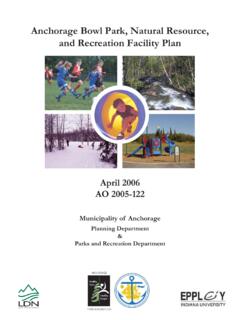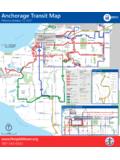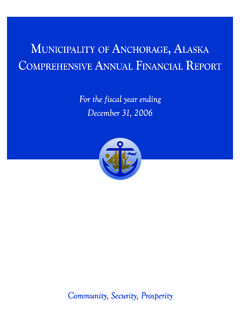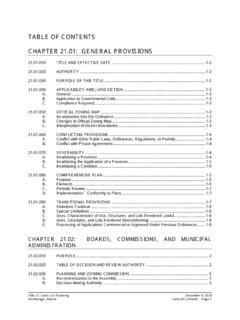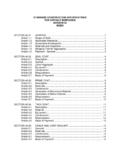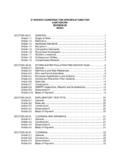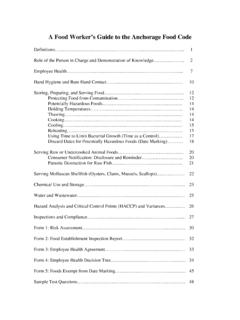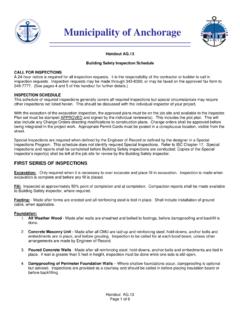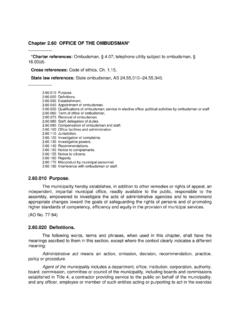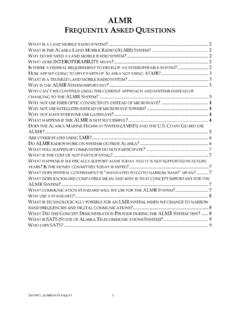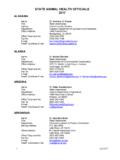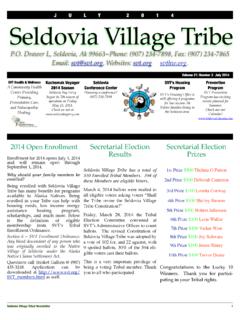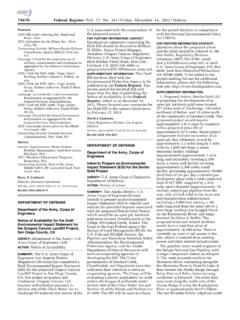Transcription of Contaminated Soil POLICY 2008 - Anchorage, Alaska
1 Contaminated soil , SPILL RESIDUE, DRUMS, TANKS AND ASSOCIATED PRODUCT PIPING DISPOSAL POLICY EFFECTIVE DATE: September 1, 1988 REVISED DATE: April 1, 2008 I. AUTHORITY TO ESTABLISH DISPOSAL POLICY : The authority by which the Solid Waste Services (SWS) Department establishes disposal policies and procedures and conducts disposal operations is contained within the anchorage Municipal Code and the State of Alaska Department of Environmental Conservation's Solid Waste Management Regulations, 18 AAC 60, as amended through July 11, 1999. II. APPLICABILITY: This POLICY applies to the disposal of soils, residues and other solid waste associated with the release or spill of petroleum products or other chemicals.
2 This POLICY is to be used as a guideline to determine the acceptability of these materials for disposal at the anchorage Regional Landfill (ARL). Due to the potential of encountering a wide variety of petroleum products and chemicals, it will often be necessary to make a case by case determination on the acceptability of specific soils and residues. III. PROHIBITED MATERIALS: Under NO circumstances will the following be accepted for disposal at the ARL, Central Transfer Station, or Girdwood Transfer Station: A. Contaminated soil , spill residue or other solid waste generated outside the boundaries of the Municipality of anchorage .
3 B. Contaminated soil , spill residue or other solid waste in any quantity which exhibits hazardous waste characteristics for ignitability, corrosively, reactivity or toxicity, or contains listed hazardous waste, or substances which could be classified as a hazardous waste, at levels which exceed prohibitions as defined by the US Environmental Protection Agency (USEPA) or the Alaska Department of Environmental Conservation (ADEC). C. Contaminated soil , spill residue or other solid waste which contains concentrations of Polychlorinated Biphenyls (PCB) greater than 1 mg/Kg. D. Contaminated soil , spill residue or other solid waste, which contains free liquids as defined by the USEPA Paint Filter Test, including petroleum products, chemicals or water.
4 E. Contaminated soil , spill residue, or other solid waste associated with Contaminated soils or spill residues in drums with a capacity greater than 10 gallons. If Contaminated soil , spill residue, or other solid waste associated with Contaminated soils or spill residues is brought to the landfill in drums larger than 10 gallons, the material must meet the acceptance criteria contained in this POLICY document, the material will be emptied from the drums at the landfill by the person(s) who brought Consoils 2001 2 the drums to the landfill and the drums will then either be removed from the landfill or, if they are to be disposed, must meet the criteria contained in Section VI.
5 F. Sludges from any tank, floor drain, sand-grit separator or catch basin pumping or cleaning operations. IV. LIMITATIONS FOR ACCEPTANCE OF SPECIFIC POLLUTANTS: ALL LIMITATION MEASUREMENTS ARE DRY-WEIGHT MEASUREMENTS REFERENCED TO A soil MATRIX. A. Contaminated soil , spill residue, or other solid waste associated with underground storage tanks and systems having contained or containing only petroleum products, other than used oil or an unknown petroleum product, will be acceptable for disposal at the ARL provided the material is not prohibited as in Section III above and all of the following limitation are not exceeded: 1.
6 GASOLINE RANGE ORGANICS (GRO) LIMIT - < 500 mg/Kg Alaska TEST METHOD AK101. 2. DIESEL RANGE ORGANICS (DRO) LIMIT - < 1000 mg/Kg Alaska TEST METHOD AK102. 3. TOTAL BENZENE, TOLUENE, ETHYLBENZENE AND XYLENE (BTEX) LIMIT - < 50 mg/Kg TEST METHOD EPA 8020. 4. LEAD (leaded gasoline spills only) LIMIT - < mg/L TEST METHOD TCLP, OR MAXIMUM THEORETICAL LEACHATE CONCENTRATION IN ACCORDANCE WITH USEPA MEMORANDUM #36, TOTAL ANALYSIS VS. TCLP , DATED January 12, 1993. B. Contaminated soil , spill residue, or other solid waste associated with underground storage tanks and systems having contained or containing used oil products, will be acceptable for disposal at the ARL provided the material is not prohibited as in Section II above and each of the following limitations are not exceeded: 1.
7 RESIDUAL-RANGE ORGANICS (RRO) LIMIT - < 1000 mg/Kg Alaska TEST METHOD AK103. 2. TOTAL BENZENE, TOLUENE, ETHYLBENZENE AND XYLENE (BTEX) LIMIT - < 50 mg/Kg TEST METHOD EPA 8020. 3. LEAD LIMIT - < mg/L TEST METHOD TCLP, OR MAXIMUM THEORETICAL LEACHATE CONCENTRATION IN ACCORDANCE WITH USEPA MEMORANDUM #36, TOTAL ANALYSIS VS. TCLP , DATED January 12, 1993. Consoils 2001 3 4. ARSENIC LIMIT - < mg/L TEST METHOD TCLP, OR MAXIMUM THEORETICAL LEACHATE CONCENTRATION IN ACCORDANCE WITH USEPA MEMORANDUM #36, TOTAL ANALYSIS VS. TCLP , DATED January 12, 1993.
8 5. CHROMIUM LIMIT - < mg/L TEST METHOD TCLP, OR MAXIMUM THEORETICAL LEACHATE CONCENTRATION IN ACCORDANCE WITH USEPA MEMORANDUM #36, TOTAL ANALYSIS VS. TCLP , DATED January 12, 1993. 6. TOTAL COMPOSITE OF HALOGENATED VOLIATILE ORGANIC COMPOUNDS LIMIT - < 100 mg/Kg TEST METHOD EPA 8021H. 7. POLYCHLORINATED BIPHENYLS LIMIT - < 1 mg/Kg TEST METHOD - EPA 8081. C. Contaminated soil , spill residue, or other solid waste associated with underground storage tanks and systems having contained or containing an unknown petroleum product, will be acceptable for disposal at the ARL provided the material is not prohibited as in Section II above and each of the following limitations are not exceeded: 1.
9 RESIDUAL-RANGE ORGANICS (RRO) LIMIT - < 1000 mg/Kg BY A COMPOSITE ANALYSIS OF Alaska TEST METHODS AK 101, 102 AND 103. 2. TOTAL BENZENE, TOLUENE, ETHYLBENZENE AND XYLENE (BTEX) LIMIT - < 50 mg/Kg TEST METHOD EPA 8020. 3. LEAD LIMIT - < mg/L TEST METHOD TCLP, OR MAXIMUM THEORETICAL LEACHATE CONCENTRATION IN ACCORDANCE WITH USEPA MEMORANDUM #36, TOTAL ANALYSIS VS. TCLP , DATED January 12, 1993. 4. ARSENIC LIMIT - < mg/L TEST METHOD TCLP, OR MAXIMUM THEORETICAL LEACHATE CONCENTRATION IN ACCORDANCE WITH USEPA MEMORANDUM #36, TOTAL ANALYSIS VS.
10 TCLP , DATED January 12, 1993. - 5. CHROMIUM LIMIT - < mg/L Consoils 2001 4 TEST METHOD TCLP, OR MAXIMUM THEORETICAL LEACHATE CONCENTRATION IN ACCORDANCE WITH USEPA MEMORANDUM #36, TOTAL ANALYSIS VS. TCLP , DATED January 12, 1993. 6. TOTAL COMPOSITE OF HALOGENATED VOLIATILE ORGANICS LIMIT - < 100 mg/Kg TEST METHOD EPA 8021H. 7. POLYCHLORINATED BIPHENYLS LIMIT - < 1 mg/Kg TEST METHOD - EPA 8081. D. The acceptability for disposal at the ARL of any Contaminated soil , spill residue, or other solid waste associated with underground storage tanks and systems containing NON-PETROLEUM products will be on a case by case basis as determined by SWS, Tele.
